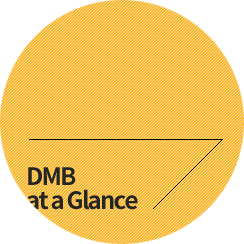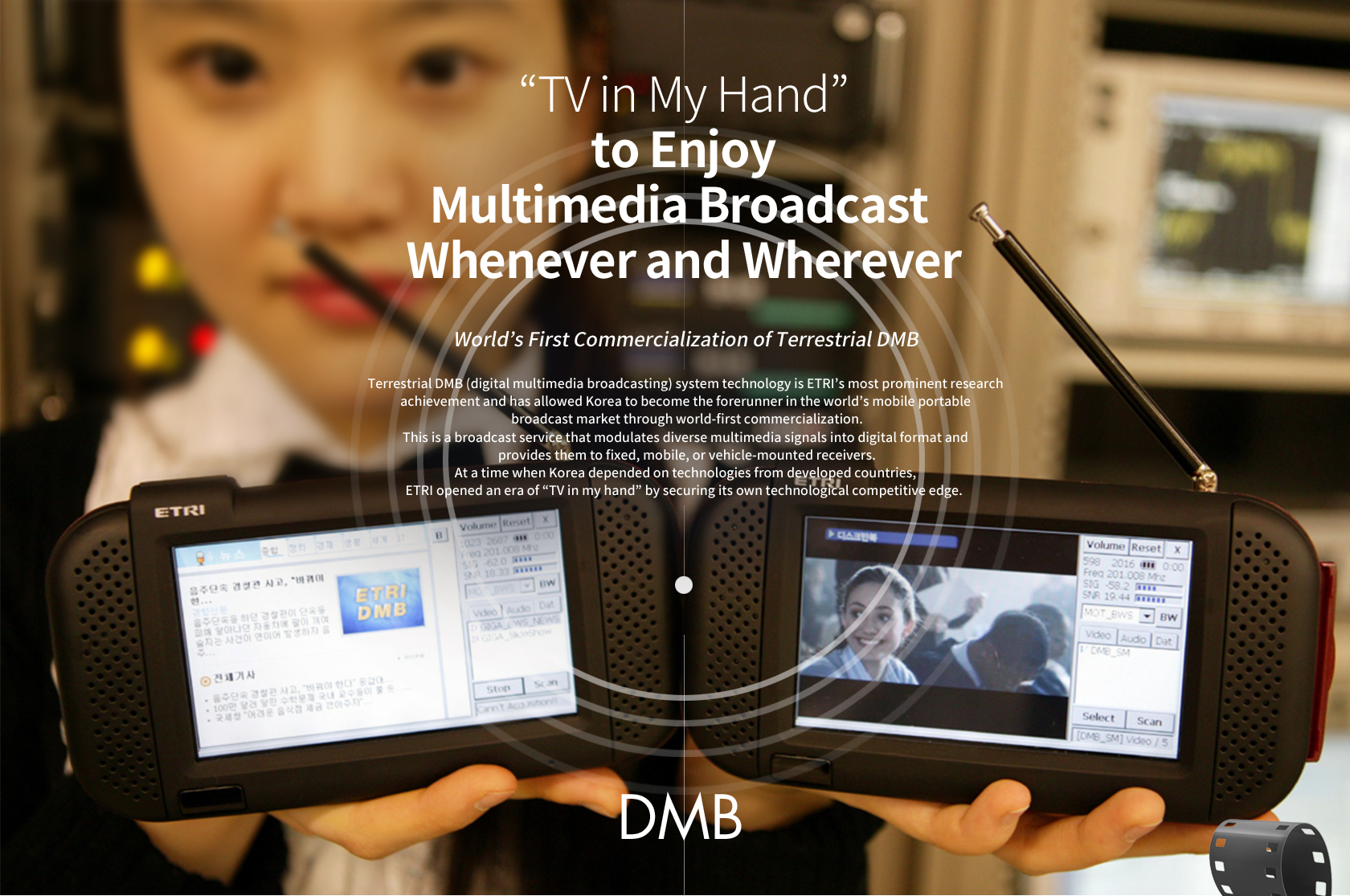
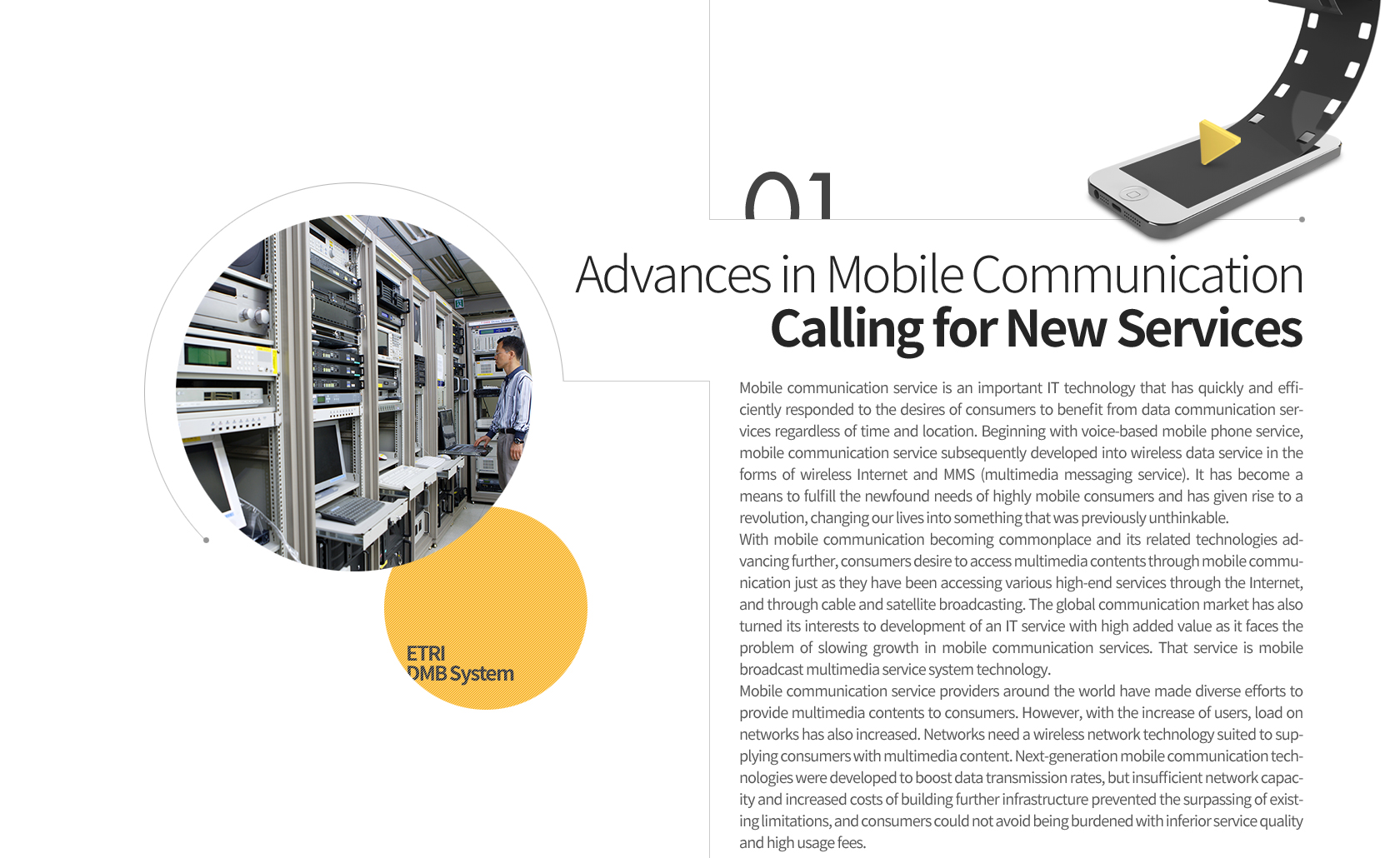
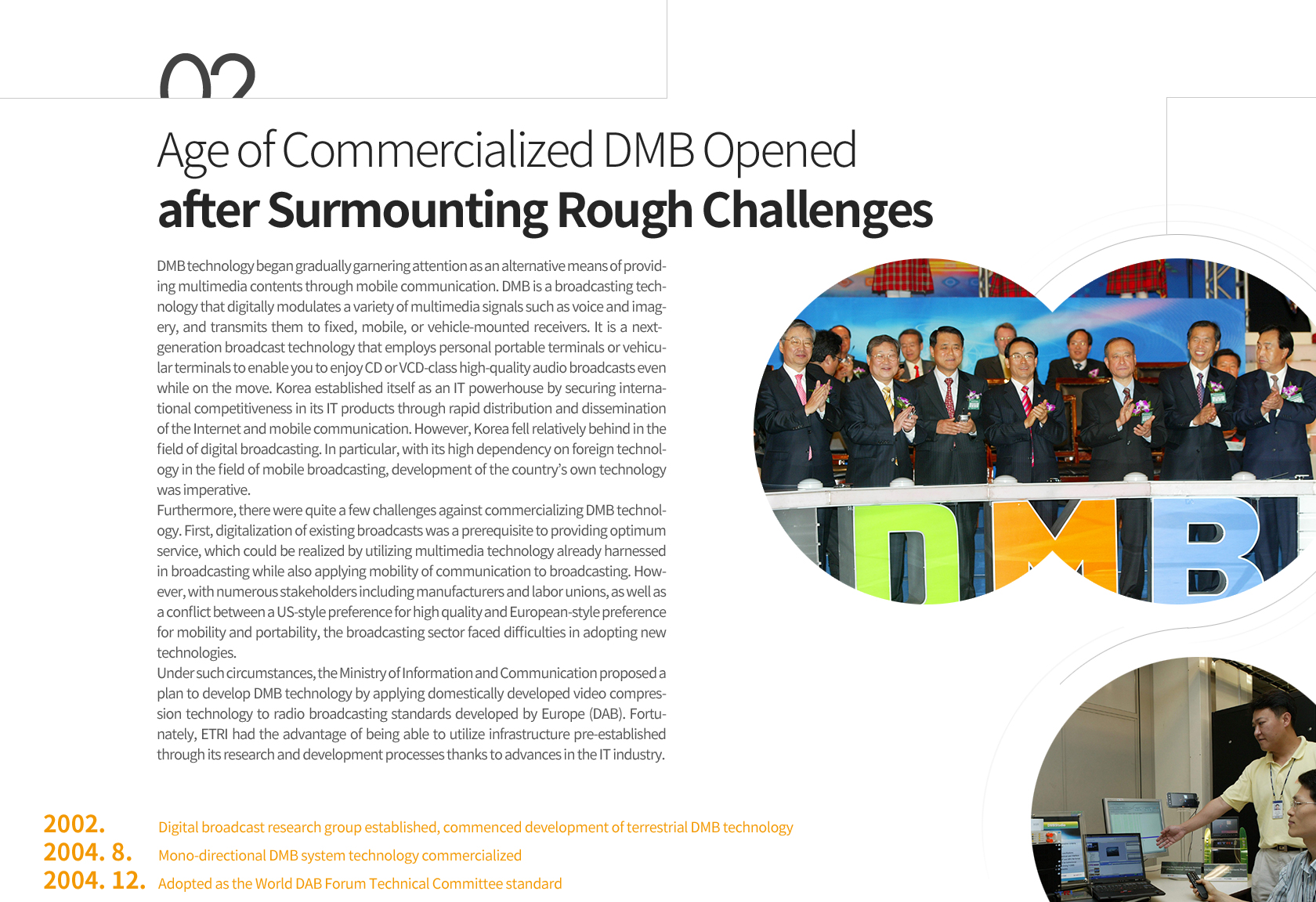
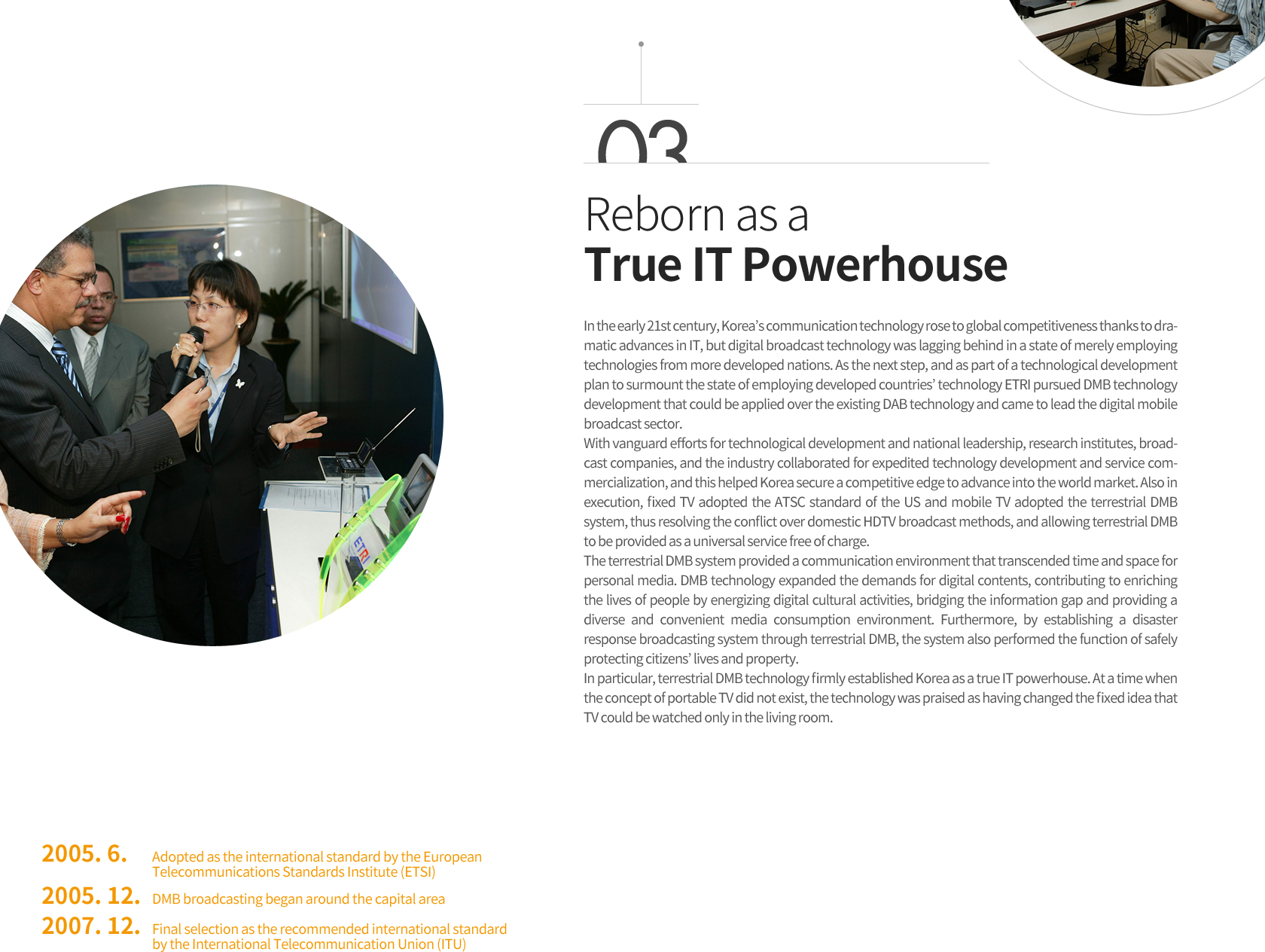
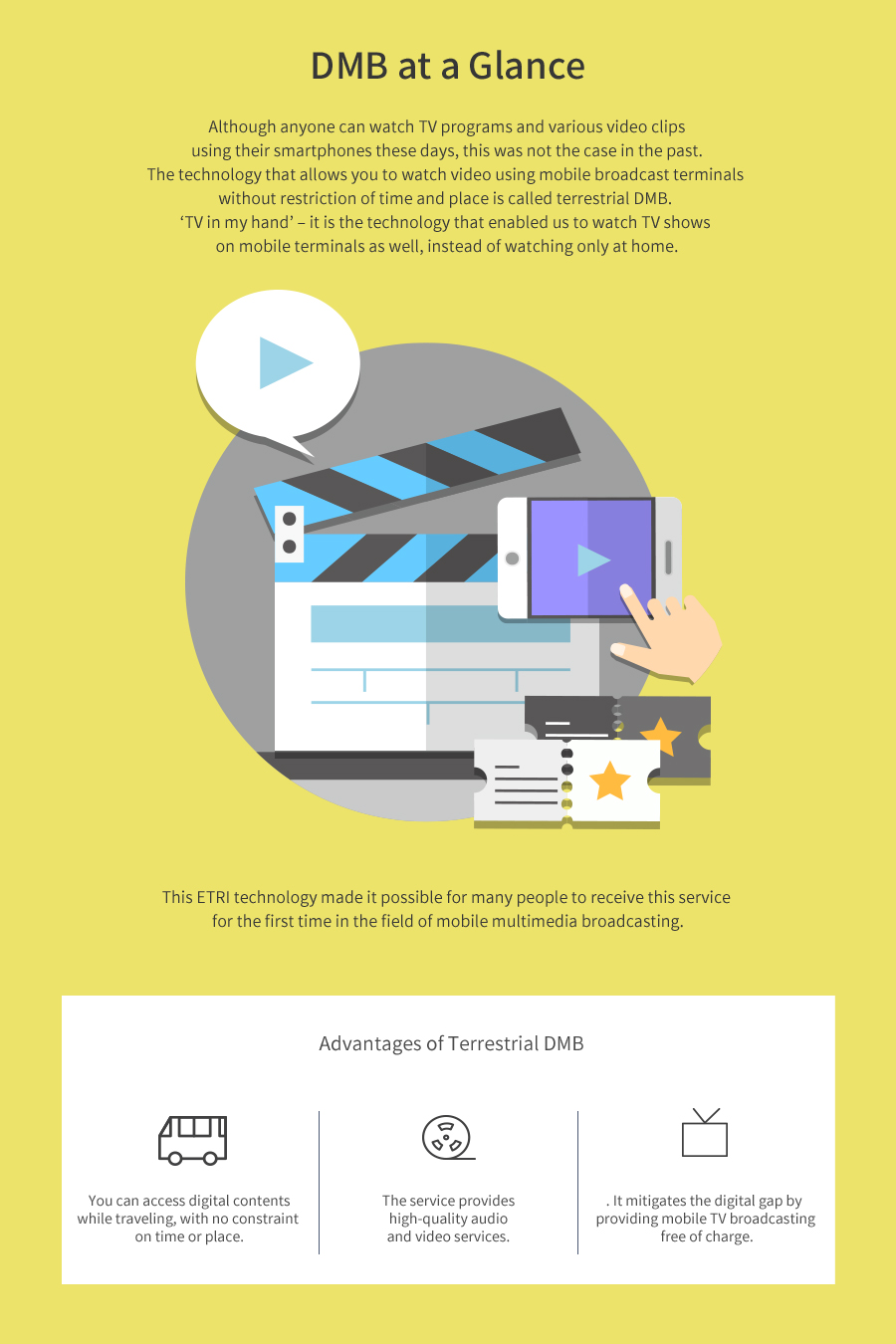

“TV in My Hand”
to Enjoy
Multimedia Broadcast
Whenever and Wherever
World’s First Commercialization of Terrestrial DMB
Terrestrial DMB (digital multimedia broadcasting) system technology is ETRI’s most prominent research achievement and has allowed Korea to become the forerunner in the world’s mobile portable broadcast market through world-first commercialization. This is a broadcast service that modulates diverse multimedia signals into digital format and provides them to fixed, mobile, or vehicle-mounted receivers. At a time when Korea depended on technologies from developed countries, ETRI opened an era of “TV in my hand” by securing its own technological competitive edge.

01
Advances in Mobile Communication
Calling for New Services
Mobile communication service is an important IT technology that has quickly and efficiently responded to the desires of consumers to benefit from data communication services regardless of time and location. Beginning with voice-based mobile phone service, mobile communication service subsequently developed into wireless data service in the forms of wireless Internet and MMS (multimedia messaging service). It has become a means to fulfill the newfound needs of highly mobile consumers and has given rise to a revolution, changing our lives into something that was previously unthinkable.
With mobile communication becoming commonplace and its related technologies advancing further, consumers desire to access multimedia contents through mobile communication just as they have been accessing various high-end services through the Internet, and through cable and satellite broadcasting. The global communication market has also turned its interests to development of an IT service with high added value as it faces the problem of slowing growth in mobile communication services. That service is mobile broadcast multimedia service system technology.
Mobile communication service providers around the world have made diverse efforts to provide multimedia contents to consumers. However, with the increase of users, load on networks has also increased. Networks need a wireless network technology suited to supplying consumers with multimedia content. Next-generation mobile communication technologies were developed to boost data transmission rates, but insufficient network capacity and increased costs of building further infrastructure prevented the surpassing of existing limitations, and consumers could not avoid being burdened with inferior service quality and high usage fees.

02
Age of Commercialized DMB Opened
after Surmounting Rough Challenges
DMB technology began gradually garnering attention as an alternative means of providing multimedia contents through mobile communication. DMB is a broadcasting technology that digitally modulates a variety of multimedia signals such as voice and imagery, and transmits them to fixed, mobile, or vehicle-mounted receivers. It is a next-generation broadcast technology that employs personal portable terminals or vehicular terminals to enable you to enjoy CD or VCD-class high-quality audio broadcasts even while on the move. Korea established itself as an IT powerhouse by securing international competitiveness in its IT products through rapid distribution and dissemination of the Internet and mobile communication. However, Korea fell relatively behind in the field of digital broadcasting. In particular, with its high dependency on foreign technology in the field of mobile broadcasting, development of the country’s own technology was imperative.
Furthermore, there were quite a few challenges against commercializing DMB technology. First, digitalization of existing broadcasts was a prerequisite to providing optimum service, which could be realized by utilizing multimedia technology already harnessed in broadcasting while also applying mobility of communication to broadcasting. However, with numerous stakeholders including manufacturers and labor unions, as well as a conflict between a US-style preference for high quality and European-style preference for mobility and portability, the broadcasting sector faced difficulties in adopting new technologies.
Under such circumstances, the Ministry of Information and Communication proposed a plan to develop DMB technology by applying domestically developed video compression technology to radio broadcasting standards developed by Europe (DAB). Fortunately, ETRI had the advantage of being able to utilize infrastructure pre-established through its research and development processes thanks to advances in the IT industry.
ETRI founded the Digital Broadcasting Research Division in 2002 and commenced the development of DMB technology in cooperation with other organizations including KBS, MBC, Samsung, LG, and Personal Telecom. ETRI contributed to development of element technologies by establishing a research direction or objectives. As a result, ETRI succeeded in developing terrestrial DMB for the first time in the world in 2003, and in December 2005 began the world’s first major broadcasting service through mobile communication using terrestrial waves.
The technology developed this way was adopted as a standard by international organizations including Europe’s ETSI, thus opening the path to market expansion. With trial broadcasts conducted in Canada, Europe, China, and elsewhere, Korea was able to boast its superior technology widely across the world.

03
Reborn as a
True IT Powerhouse
In the early 21st century, Korea’s communication technology rose to global competitiveness thanks to dramatic advances in IT, but digital broadcast technology was lagging behind in a state of merely employing technologies from more developed nations. As the next step, and as part of a technological development plan to surmount the state of employing developed countries’ technology ETRI pursued DMB technology development that could be applied over the existing DAB technology and came to lead the digital mobile broadcast sector.
With vanguard efforts for technological development and national leadership, research institutes, broadcast companies, and the industry collaborated for expedited technology development and service commercialization, and this helped Korea secure a competitive edge to advance into the world market. Also in execution, fixed TV adopted the ATSC standard of the US and mobile TV adopted the terrestrial DMB system, thus resolving the conflict over domestic HDTV broadcast methods, and allowing terrestrial DMB to be provided as a universal service free of charge.
The terrestrial DMB system provided a communication environment that transcended time and space for personal media. DMB technology expanded the demands for digital contents, contributing to enriching the lives of people by energizing digital cultural activities, bridging the information gap and providing a diverse and convenient media consumption environment. Furthermore, by establishing a disaster response broadcasting system through terrestrial DMB, the system also performed the function of safely protecting citizens’ lives and property.
In particular, terrestrial DMB technology firmly established Korea as a true IT powerhouse. At a time when the concept of portable TV did not exist, the technology was praised as having changed the fixed idea that TV could be watched only in the living room.
- 2002.
- Digital broadcast research group established, commenced development of terrestrial DMB technology
- 2004. 08.
- Mono-directional DMB system technology commercialized
- 2004. 12.
- Adopted as the World DAB Forum Technical Committee standard
- 2005. 06.
- Adopted as the international standard by the European Telecommunications Standards Institute (ETSI)
- 2005. 12.
- DMB broadcasting began around the capital area
- 2007. 12.
- Final selection as the recommended international standard by the International Telecommunication Union (ITU)







